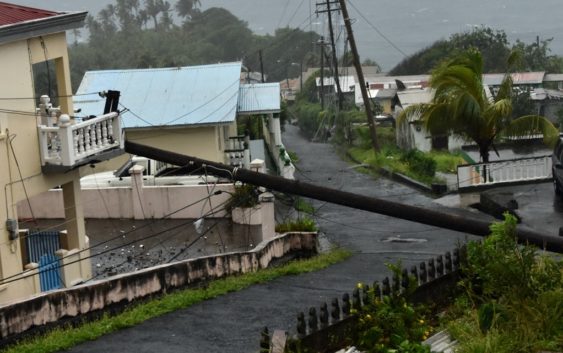- Austin adopts new map that greatly expands area at risk of wildfire
- CenterPoint Energy accelerates infrastructure improvements ahead of hurricane season
- Carolina Hurricanes playoff tickets go on sale Thursday
- Ask the Meteorologist: Why do tornadoes target Tornado Alley, Dixie Alley?
- Nonprofit closes distribution site that aided thousands after Hurricane Helene
'Elsa' falls back to tropical storm as it batters Haiti

The storm is responsible for one death in St. Lucia.
PORT-AU-PRINCE, Haiti — Hurricane Elsa fell back to tropical storm force as it brushed past Haiti and the Dominican Republic on Saturday and threatened to unleash flooding and landslides before taking aim at Cuba and Florida.
The storm was centered about 255 miles (410 kilometers) east of Kingston, Jamaica, and was moving west-northwest at 29 mph (46 kph). It had maximum sustained winds of 70 mph (110 kph) as the tropical storm, which had been a Category 1 hurricane earlier on Saturday, weakened during its approach to Hispaniola and Cuba, according to the National Hurricane Center in Miami.
The long-term forecast track showed it heading toward Florida as a tropical storm by Tuesday morning, but some models would carry it into the Gulf or up the Atlantic Coast.
At least one death was reported in St. Lucia, according to the Caribbean Disaster Emergency Management Agency.
In Haiti, authorities used social media to alert people about the storm and urged them to evacuate if they lived near water or mountain flanks.
“The whole country is threatened,” the Civil Protection Agency said in a statement. “Make every effort to escape before it’s too late.”
Haiti is especially vulnerable to floods and landslides because of widespread erosion and deforestation. In addition, a recent spike in gang violence has forced thousands of people to flee from their homes, so the civil protection agency is running low on basic items including food and water, director Jerry Chandler told The Associated Press.
“It’s been three weeks that we’ve been supporting families who are running away from gang violence,” he said. “We are working at renewing our stocks, but the biggest problem is logistics.”
He said officials are still trying to figure out how to deliver supplies to Haiti’s southern region, which braced for Elsa’s impact.
Meanwhile, people bought water and food before the storm approached.
“I’m protecting myself the best that I can. Civil protection is not going to do that for me,” said Darlene Jean-Pierre, 35, as she bought six jugs of water along with vegetables and fruit. “I have other worries about the street … I have to worry about gangs fighting. In addition to this, we have a hurricane. I don’t know what kind of catastrophe this is going to cause.”
A hurricane warning remains in effect from the Haitian capital of Port-au-Prince to the southern border with the Dominican Republic. A hurricane watch was issued for the Cuban provinces of Camaguey, Granma, Guantanamo, Holguin, Las Tunas, and Santiago de Cuba. Some of those provinces have reported a high number of COVID-19 infections, raising concerns that the storm could force large groups of people to seek shelter together.
“Anticipating is the key word,” said Cuban President Miguel Díaz-Canel, adding that vaccination efforts would continue. “Let’s take care of lives and property.”
In the neighboring Dominican Republic, which shares the island of Hispaniola with Haiti, authorities opened more than 2,400 shelters as forecasters warned of heavy rains. Officials also ordered evacuations ahead of the storm as people kept stocking up on supplies.
Some people worried about the state of their homes, with many living under corrugated roofing.
“I have a lot of leaks in my zinc,” said María Ramos. “What are we going to do? Only God knows.”
Elsa was forecast to brush past the southernmost point of Hispaniola by Saturday afternoon and then take aim at communities in southern Haiti.
The storm already had ripped off roofs, destroyed crops and downed trees and power lines in the eastern Caribbean on Friday, with damage reported in Barbados, St. Lucia and in St. Vincent and the Grenadines, which also suffered massive volcanic eruptions that began in April.
At least 43 homes and three police stations were damaged, said St. Vincent Prime Minister Ralph Gonsalves.
“We expect that this number will increase as reports keep coming in,” he said. “We have some damage, but it could have been far worse.”
In St. Lucia, the wind damaged a secondary school, pummeling desks, overturning chairs and sending papers flying after blowing off the roof and siding. Officials also reported significant damage to roofs, including major damage at three government buildings.
A similar report emerged from Barbados, where more than 580 roofs were damaged, dozens of trees and power lines fell and about 50% of customers were still without power.
Meanwhile, authorities in Puerto Rico rescued eight people, including two children, in stormy conditions after their boat sank amid 8- to 10-foot (2- to 3-meter) waves.
Elsa was the first hurricane of the Atlantic season and the earliest fifth-named storm on record. It is forecast to drop 4 to 8 inches (10 to 20 centimeters) of rain with maximum totals of 15 inches (38 centimeters) across portions of southern Hispaniola and Jamaica.
Coto reported from San Juan, Puerto Rico and Sanon from Port-au-Prince, Haiti. Ramón Carmona in the Dominican Republic contributed to this report.